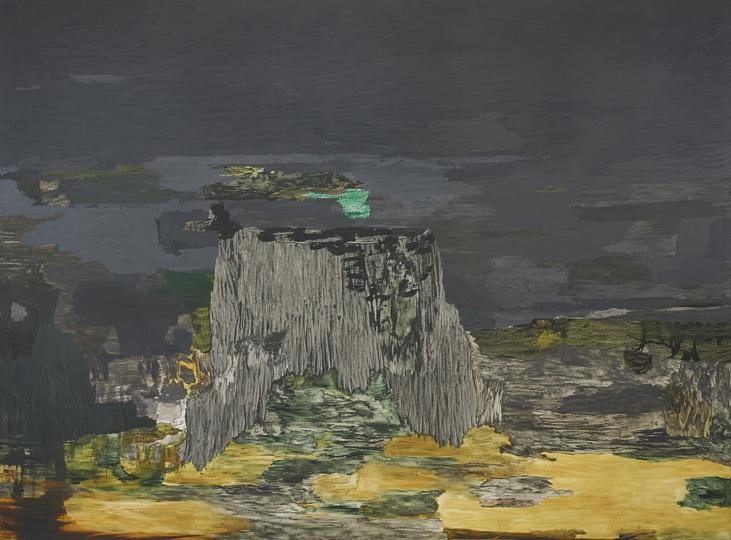Andreas Eriksson
29 Jan - 23 Mar 2014
ANDREAS ERIKSSON
29 January - 23 March 2014
The spring season kicks off with the first ever largescale solo exhibition by Andreas Eriksson, Bonniers Konsthall’s 2014 featured guest artist. Since adolescence, Andreas Eriksson has been occupied with painting, both as a technique and theme. He paints, but also uses expressions such as photography, sculpture and weaving to explore the painterly as such. Many connect his work to a Northern European Romantic painting tradition – his motifs are often derived from the nature surrounding Kinnekulle where he has his studio. The exhibition at Bonniers Konsthall presents works from the last ten years, but also new works related to the gallery's architecture and surrounding urban environment.
It’s difficult to not talk immediately about Andreas Eriksson’s life in his studio on Kinnekulle in Västergötland, especially considering that most of his imagery is evocative of nature. He consciously lives separated from everything that belongs to the big city life, not because he wants to live an isolated life, but because in the early 2000s he developed a hypersensitivity to electricity. He traded a life in the artist mecca of Berlin for the breadth of Kinnekulle. His explorations of the ancient landscape can be found in paintings, photos, fabrics and sculptures. His immediate surroundings appear in artworks and have also been important in working on the exhibition at Bonniers Konsthall. The exhibition has emerged as a manifestation of the joining of the two locations. Firstly the artist’s studio, with its stunning views that overlook the waters of Lake Vänern, and Bonniers Konsthall in urban Stockholm. He has used the winter light surrounding the gallery and built an exhibition that spans his entire ouevre with painting, photography, sculpture, film and textile.
Bonniers Konsthall first exhibited Andreas Eriksson’s work in Life Forms in 2009, one of our first group exhibitions that, through contemporary art, sought traces of the American artist Robert Smithson’s thoughts on a greater geological time outside of mankind’s quickly ticking clock. The cosmos, the earth and the minerals’ slow clockwork still ticks in Andreas Eriksson’s work. In his paintings Eriksson builds up structures using blocks, layers and brushstrokes of colour that could be seen as landscapes, soil strata, moss fibres, leaf-cell structures, or simply after-images on the retina from looking at blinding-white snow.
Andreas Eriksson has used the winter light and the snowy view from the gallery overlooking the train tracks as a model for new works – three fabrics in damask. He has had a number of individuals to help him as the labor process has been slow and demanding – from translating the photograph into a kind of pattern, which his weaver Hans Thomsson interpreted at the loom. The works have since been given their final shape in Handarbetets Vänner (the “Hand Craft Friends”) studio out on Djurgården in Stockholm, where the inked details have been embroidered by hand.
29 January - 23 March 2014
The spring season kicks off with the first ever largescale solo exhibition by Andreas Eriksson, Bonniers Konsthall’s 2014 featured guest artist. Since adolescence, Andreas Eriksson has been occupied with painting, both as a technique and theme. He paints, but also uses expressions such as photography, sculpture and weaving to explore the painterly as such. Many connect his work to a Northern European Romantic painting tradition – his motifs are often derived from the nature surrounding Kinnekulle where he has his studio. The exhibition at Bonniers Konsthall presents works from the last ten years, but also new works related to the gallery's architecture and surrounding urban environment.
It’s difficult to not talk immediately about Andreas Eriksson’s life in his studio on Kinnekulle in Västergötland, especially considering that most of his imagery is evocative of nature. He consciously lives separated from everything that belongs to the big city life, not because he wants to live an isolated life, but because in the early 2000s he developed a hypersensitivity to electricity. He traded a life in the artist mecca of Berlin for the breadth of Kinnekulle. His explorations of the ancient landscape can be found in paintings, photos, fabrics and sculptures. His immediate surroundings appear in artworks and have also been important in working on the exhibition at Bonniers Konsthall. The exhibition has emerged as a manifestation of the joining of the two locations. Firstly the artist’s studio, with its stunning views that overlook the waters of Lake Vänern, and Bonniers Konsthall in urban Stockholm. He has used the winter light surrounding the gallery and built an exhibition that spans his entire ouevre with painting, photography, sculpture, film and textile.
Bonniers Konsthall first exhibited Andreas Eriksson’s work in Life Forms in 2009, one of our first group exhibitions that, through contemporary art, sought traces of the American artist Robert Smithson’s thoughts on a greater geological time outside of mankind’s quickly ticking clock. The cosmos, the earth and the minerals’ slow clockwork still ticks in Andreas Eriksson’s work. In his paintings Eriksson builds up structures using blocks, layers and brushstrokes of colour that could be seen as landscapes, soil strata, moss fibres, leaf-cell structures, or simply after-images on the retina from looking at blinding-white snow.
Andreas Eriksson has used the winter light and the snowy view from the gallery overlooking the train tracks as a model for new works – three fabrics in damask. He has had a number of individuals to help him as the labor process has been slow and demanding – from translating the photograph into a kind of pattern, which his weaver Hans Thomsson interpreted at the loom. The works have since been given their final shape in Handarbetets Vänner (the “Hand Craft Friends”) studio out on Djurgården in Stockholm, where the inked details have been embroidered by hand.

